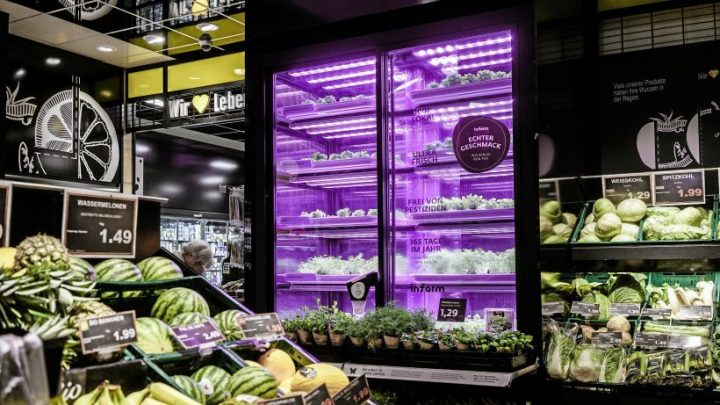

Infarm is a Berlin-based startup making produce as fresh and sustainable as possible for city dwellers.
The company has built over 700 modular farms inside supermarkets and restaurants around the world. The leafy greens, lettuces, and microgreens are practically harvested for consumers at the point of sale meaning fewer transportation emissions. Innovation Origins spoke with Infarm’s Emmanuel Evita to find out how the farms work and what the future of supermarkets could look like.
How does Infarm work?
Instead of building large-scale farms outside of the city, we’re distributing the farms in the city. Our modular approach to farming is more sustainable than traditional agriculture. Each in-store farm uses 95% less water and 75% less fertilizer than soil-based agriculture.
We control our farms remotely using sensors and a centralized, adjustable cloud-based platform. Our system provides seedlings with an ideal combination of light spectrums, temperature, pH, and nutrients for optimal growth. Infarm’s growers visit the farms regularly to harvest mature plants and place them at the point of sale. Our customers have access to the plants at their freshest points.
It seems like a no brainer for many stakeholders. What are the risks of having a modular farm onsite?
We don’t believe there are any risks. Living plants are grown onsite mean more nutritious, tastier, and fresher food. Once the farms are installed onsite, we manage the growth and maintenance of the plants.
Today we have partnerships with more than 30 major food retailers, and we have over 700 farms in stores and distribution centers. We have received positive feedback from our partners, which we’re thrilled about. We’ve found that the introduction of our plants tends to have a positive impact on the basket size of the fresh produce department in supermarkets.
Does Infarm produce enough to sustain consumers from a typical supermarket?
Our hubs offer us the ability to respond to adjustments in demand. Our modular format of growth and production is very responsive to the needs of our customers. It couldn’t be more different from models offered by traditional agriculture.
What are the margins compared to produce from industrial farms?
Retailers set the price for the products we provide in-store. The price does not tend to be significantly higher than other product offerings.
How will space at a restaurant or supermarket impact the ability to grow?
Infarm’s technology is specifically designed to work anywhere in any available space. From a single farming unit in a restaurant to a few farming units in a supermarket or up to multiple series of farming units chained together in a distribution center.
Infarm harvest herbs, leafy greens, and lettuces – what’s next?
Our farms are easily scalable, but right now our focus is on herbs, leafy greens, lettuces, and microgreens.
We have more than 65 varieties as part of our catalog—from Italian Basil to Crystal Lettuce, to more special varieties like Peruvian Mint or Wasabi Rucola.
What could supermarkets look like in the future?
We predict that supermarkets of the future will only continue to increase their selection of fresh, locally grown produce, driven by consumer demand. The world needs to combat the shortcomings of the traditional food supply chain.
We’re already seeing this shift in many supermarkets around the world. And we believe vertical and modular farms will be instrumental in increasing these offerings, particularly in regions that aren’t as suited to local farming.
What other practical steps can the industry take towards growing and selling more local produce? How can consumers play a role?
The coronavirus pandemic has brought to light the challenges the traditional food supply chain faces. We believe vertical farming is needed in diverse countries and cities all around the world. But the Infarm approach is only one way to tackle the urgent agricultural and ecological challenges of our time. Local and organic farming will continue to be vital to food supply needs in communities everywhere. The more we can work together to tackle these problems, the better for our world.
We believe that consumers today want more nutritious, better-tasting, and more sustainable food. As consumer demand for locally grown produce continues to increase, the agriculture industry will have to adapt to keep up.
You can read more IO-articles about start-ups here.
Also interesting:
Living farm is busy breeding mealworms


